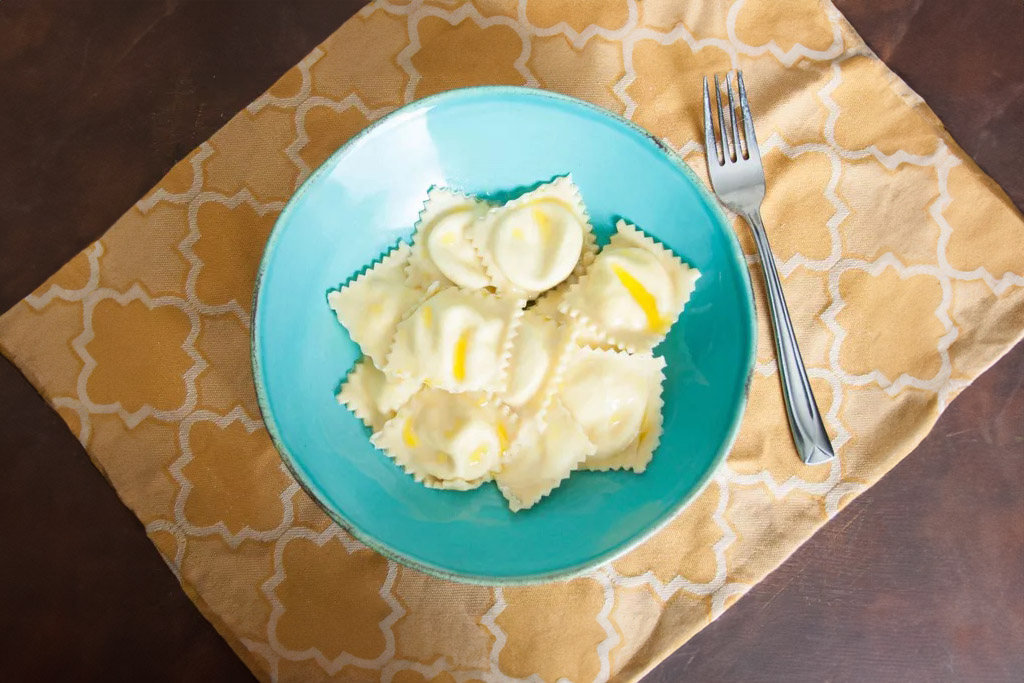Classic homemade ricotta ravioli with a tang from Parmesan cheese, a tart squeeze of lemon juice, and a subtle hit of nutmeg.
Homemade Ricotta Ravioli
This recipe for classic homemade ricotta ravioli gets its unique flavor from Parmesan cheese, a tart squeeze of lemon juice, and a subtle hint of nutmeg. All it needs is a splash of olive oil and it’s ready to serve.
Ingredients
- 15 ounces fresh ricotta cheese (see note)
- 7 ounces grated mozzarella
- 2 ounces freshly grated Parmesan cheese
- 1 egg
- Kosher salt and freshly ground black pepper
- 1 recipe Classic fresh egg pasta (I used Marcella Hazan’s recipe, though it needed a lot of extra flour)
- Garlic butter source: https://happilyunprocessed.com/butter-garlic-cream-sauce/
Directions
- Lay a clean kitchen towel or a triple layer of lint-free paper towels on a rimmed baking sheet. Spread ricotta evenly over surface of towels. Top with a second clean kitchen towel or triple layer or paper towels. Press with hands or a second rimmed baking sheet and let rest 5 minutes. Transfer ricotta to a medium bowl (it should come right off the towels).
- Add Parmesan cheese, nutmeg, and lemon juice to ricotta. Season to taste with salt and pepper and stir to combine.
- Meanwhile, divide dough into four even sections. Working one section at a time, with remaining sections tightly wrapped in plastic, roll dough through machine until sheet is just under 1/16th of an inch thick (typically second-to-last setting). Cut sheet in half to create 2 pieces of dough roughly 15 inches long and 5 inches across.
- If using a ravioli mold: Place first sheet of dough over metal base. Gently and evenly press plastic mold down to make depressions in dough. Remove and fill each depression with approximately 1 tablespoon filling. Rap mold once or twice to remove any air bubbles. Place second sheet of dough over surface and pat down. Run rolling pin over dough until ridges beneath become visible. Flip the mold over and gently peel it away. If ravioli remain stuck, rap edge of mold on table. If ravioli do not separate easily, use fluted ravioli cutter to complete perforation. Cover ravioli with towel to prevent drying. Repeat with remaining dough and continue to step 6.
- If working by hand: Fold first sheet along its midline to make a light crease and re-open. Place 6 heaping tablespoons half-inch apart along length of lower half. Moisten upper half with pastry brush dipped in water and fold over, pressing down to remove air bubbles and create a seal around filling. Using fluted ravioli cutter or kitchen knife, cut between filling for 6 even squares. Cover ravioli with towel to prevent drying. Repeat with remaining dough.
- At this point, ravioli can be frozen: place ravioli on a parchment-lined rimmed baking sheet and freeze completely. Transfer to a freezer bag, press out as much air as possible, and store in freezer for up to 2 months. Frozen ravioli can be cooked straight from frozen (add 30 seconds to cooking time).
- To cook ravioli, bring a large pot of salted water to a boil. Cook ravioli by submerging in boiling water and cooking for 3 minutes (ravioli should float). Drain, reserving 1/2 cup of cooking liquid. Return ravioli and the cooking liquid to the pot. Add 1/4 cup olive oil and cook on high heat, stirring gently until oil and pasta water emulsify into a creamy sauce, about 1 minute. Serve immediately, drizzling with more extra-virgin olive oil at the table.
- Look for a high-quality ricotta that contains no gums or stabilizers, such as Calabro. If stabilizer-free ricotta is not available, you can make your own using this technique.
Special equipment: Pasta machine, ravioli maker (optional), ravioli stamp or wheel.

